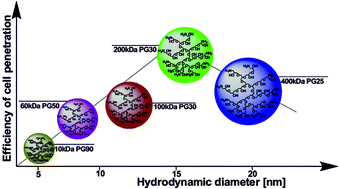Systematic adjustment of charge densities and size of polyglycerol amines reduces cytotoxic effects and enhances cellular uptake†
Abstract
Excessive cationic charge density of polyplexes during cellular uptake is still a major hurdle in the field of non-viral gene delivery. The most efficient cationic vectors such as polyethylene imine (PEI) or polyamidoamine (PAMAM) can be highly toxic and may induce strong side effects due to their high cationic charge densities. Alternatives like polyethylene glycol (PEG) are used to ‘shield’ these charges and thus to reduce the cytotoxic effects known for PEI/PEG-core–shell architectures. In this study, we compared the ability of hyperbranched polyglycerol amines (hPG amines) with different amine densities and molecular weights as non-viral cationic vectors for DNA delivery. By adjusting the hydroxyl to amine group ratio on varying molecular weights, we were able to perform a systematic study on the cytotoxic effects caused by the effective charge density in correlation to size. We could demonstrate that carriers with moderate charge density have a higher potential for effective DNA delivery as compared to high/low charged ones independent of their size, but the final efficiency can be optimized by the molecular weight. We analyzed the physicochemical properties and cellular uptake capacity as well as the cytotoxicity and transfection efficiency of these new vector systems.


 Please wait while we load your content...
Please wait while we load your content...